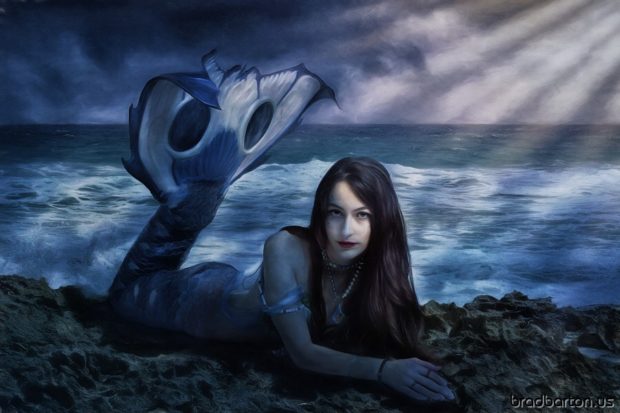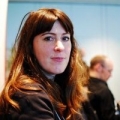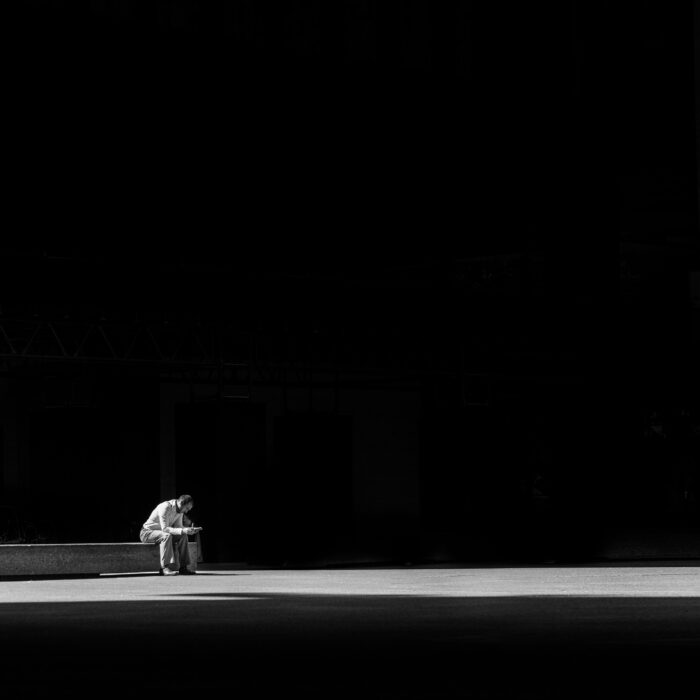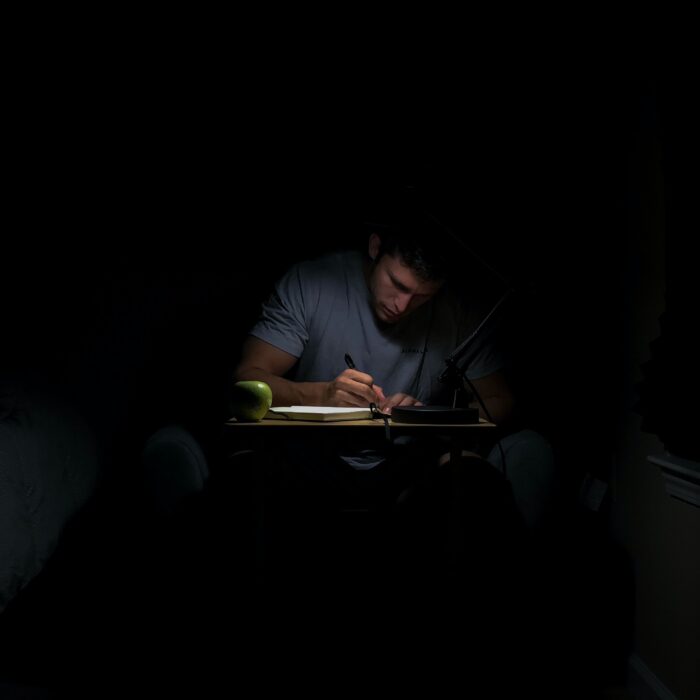You have no items in your cart. Want to get some nice things?
Go shopping
How to describe Skype’s aquatic ring tone? That digital threshold of rising blips and sinking bloops. For some it is the sweet sound of being wanted. For others it is scary. For others still it sounds like an Owl City Song.
For me, it can only mean one thing.
Do-doo-do-blip-do-doo-do-blip-do-doo-do-Blip!
Everyone has a first. Aysun had been on my mind ever since I saw her in an article in Dazed. I did what anyone in my position would do: copied and pasted her and put her in a PowerPoint. Then showed her to my agent during a brief stopover in London.
‘Wow,’ my agent said.
I clicked through the PowerPoint – titled Professional Mermaid — Aysun lay on her side beneath a rocky cliff. I liked the sombreness of her sci-fi tail and its interlocking network of blue-hued and pearlescent scales. The tip of her fluke dipped in the shallow end of a maudlin lake. The water, like the setting, was no frills but her fluke was something else. Set inside that pale creamy fluke were two enormous blue moons.
‘She’s Russian,’ I gushed.
I believed Dazed. (I think I was dazed.)
All my life I have loved mermaids. It started with Daryl Hannah in Splash and I had quickly tried to mould my prepubescent feelings into an artwork. But the terracotta mermaid I made in school ceramics broke in the kiln. Now in my early forties I was finally going to tackle mermaids again. And I was going to tackle them the way only a heterosexual mother of a one-year-old who won’t sleep could. Slowly.
Click. In the second slide Aysun sat in a giant clamshell looking Russian. To someone who has never been to Russia but has vague memories of watching Elton John’s eighties music video for Nikita. It looked like it might be cold in Aysun’s little corner of the world. She had long dark hair and a pale, otherworldly complexion. I could imagine her swallowing a shot of Stoli.
The Dazed article said she was everyone’s favourite sarcastic baby-eating mermaid. It was a line that wouldn’t appeal to everyone but it appealed to me.
Aysun was click bait.
I clicked through the rest of my slideshow: mermaids and mermen flashed their prosthetic tails winningly. And what tails. Each an artwork in its own right. Their tails are typically made of Dragon Skin silicon rubber – cured it is very strong and stretchy, it can stretch many times its original size and still rebound to its original form – such flamboyance! Such colour! Such fins. The merfolk posed near water, in water or under water. At the time, I hadn’t Skyped any of them. They were just my first haul from the Internet.
‘This is as commercial as I get,’ I told my agent.
‘What about the novel?’ she asked.
It wasn’t an unreasonable question. The mermaid is a creature of fiction, not fact, but that hadn’t stopped Aysun. I had started my great mermaid novel with gusto but after the mermaid character turned up in a small coastal village, I ran into my usual problems…what would she do?
I cruised the web in those lulls…swells of women working as mermaids filled my feed. Life got a lot more Pinteresting. Jobs to thrill your inner-child: professional mermaid! I read the Wikihow on ‘Playing the part of a mermaid.’ Walk with uncertainty it advised. The mermaid in my novel had arrived in the middle of winter. She was dripping wet. But was she uncertain? I know I was. My character walked into the local – derelict – bookstore and demanded a book on mermaids. Her accent sounded foreign, maybe Russian?
Now I had found Aysun.
I sat in my agent’s office surrounded by other people’s paperbacks. I wasn’t just pitching a non-fiction book on mermaids to my agent. I was pitching it to myself. A book isn’t a mad all-night fling that takes you far away from the edge of yourself and everything you thought was possible until you wake up rasping for the hair of the dog. No, a book is a relationship – a professional commitment — and sometimes you have to write even when you don’t feel subconscious. In fact especially when you don’t feel subconscious.
‘Do you think it’s about feminism?’ my agent asked.
I looked back at the PowerPoint. ‘Probably.’
The slideshow was open on a jpeg of Hannah Fraser: the most famous professional mermaid in the world. Her blonde hair fanned out beside her, tinged slightly green by the underwater light, she held the rusted prow of a shipwreck. Three sharks drifted by in the background like learner drivers.
‘Are they all beautiful?’ my agent asked.
Fraser wore a sequined bikini top of overlapping iridescent shells, festooned with strands of imaginary seaweed. She was undeniably beautiful, the underwater shoot was also beautiful, her breath-hold sublime. I had watched Hannah Fraser’s 2015 TEDx Talk – titled Turning Fantasy into Reality – so I knew that her work as a professional mermaid was about more than just looking the part. ‘Fantasy is usually thought of as kids’ stuff,’ Fraser said at the start of her talk.
A hardback of Watership Down sat in prime position on my agent’s bookshelf. The illustration of the twitchy rabbit on the cover could only be Fiver. In Adams’ classic, it is Fiver who foresees the destruction of the rabbit’s warren — their home.
The mermaids in my PowerPoint were also alert to the destruction of the ocean — their home. Fraser’s career had gone from underwater modelling to saving manta rays and sharks as a servant of the sea. The world was going to hell in a hand basket and Fraser was fighting back as a mermaid.
My agent asked me if I would buy a tail and try and become a mermaid as part of the book. ‘I don’t think so,’ I replied.
‘Many of us are unwilling to face reality when it’s ugly,’ Fraser said in her TEDx Talk. She was talking about the annual drive hunting of dolphins in Taiji, Japan, the site of the largest annual slaughter of dolphins and whales in the world. But somehow I thought Fraser’s work as an ocean activist also mattered because she was really, really, really good looking. Why are mermaids so synonymous with beauty? And is beauty really only skin deep? How much of it is nature, how much of it is culture?
‘My life has been a constant journey of pushing the boundaries of what is possible,’ Fraser said.
I could say the same thing about my life but it wouldn’t be as interesting because I have never swum a humpback whale.
Besides, I admired that Fraser was actually doing something about ocean conservation. I wanted to make the world a better place too – but how?
In the last census, 1000 Americans identified ‘mermaid’ as their profession. The climate is changing, ocean temperatures are rising and mermaids are on the rise too even though the world has been utterly Trumped. In the epoch of the Anthropocene and the Post-truth era, is escapism the only way out?
‘What possibilities exist when you bring your fantasy up from the depths to the shores of reality?’ Hannah asked at the end of her Ted X Talk. It was a rhetorical question but also a challenge.
‘Why don’t you contact her?’ my agent asked.
‘Hannah Fraser? She’d never talk to me,’ I said. ‘She’s like famous.’
*
Do-doo-do-blip-do-doo-do-blip-do-doo-do-BLOOP-BLOOP!
Skype Number One: transmission failed.
I could hear her, but she couldn’t hear me.
What is it about Skype? Why is it often so shit?
So I drifted around collecting jpegs of mermaids swimming in translucent seas that also heave with plastics and pollution, below the surface their flukes stretched toward the sand, heavy as anchors. Do-do-doo-blip. In bathtubs their Dragon skin silicon tails overflowed. These tails retail for thousands of dollars so check your privilege mermaids. Do-doo-do-blip. A line kept going round and round in my mind: I’ve heard the mermaids singing. Each to each. I do not think they will sing to me. Do-doo-do-Blip! Bloop! THEN A 7.8 EARTHQUAKE WOKE US UP ONE NIGHT AND I RAN AND GRABBED MY DAUGHTER OUT OF HER COT AS THE HOUSE SHOOK AND ROCKED FOR TWO MINUTES. For months afterwards the Pacific Ocean outside the window seemed less like a beautiful metaphor and more like a natural disaster waiting to happen. I Googled the poem and found out that T.S. Eliot wrote The Love Song of J. Alfred Prufrock and the mermaids only appear at the end. I wasn’t sure they would sing to me either, but maybe they would Skype?
I tried again. Second time lucky. T.S Eliot probably could have described the Skype ringtone better than me, but he’s not here, so this will have to do-doo-do-blip-do-doo-do-blip!
A scratch and a shuffle as the world tilted upside down.
‘Hi, I’m nervous,’ I said. ‘You’re my first mermaid.’
‘I’m nervous too.’
Onscreen, the pixels clicked into place like scales and Aysun swum into view. She was wearing fine-rimmed glasses.
Did I mention that Aysun is the Turkish word for moon? I hazard there are two types of writers: those who want to write about Carly Seaman and those who want to write about Aysun.
Carly Seaman lives in Texas, where she is employed in the mermaid lagoon at Scarborough Fair, a Renaissance Festival, set in a re-created 16th Century English village. Yes, Seaman is her real surname. (‘It was kind of a terrible last name until I started working as a mermaid and then it became significantly less so.’) 2018 will be her fifth year at Scarborough in the mermaid lagoon. Her voice is even, precise, considered. Then she clicks into Aysun and her rrrs start to roll.
‘My accent in the beginning was passable but now it is actually convincing. I have had people come through and think I was from Russia but some of the patrons are very easy to fool.’
It’s a one-way path through the mermaid lagoon. Patrons have to pass two other mermaids dressed in costume tails that are not made to fit.
One wears a horn. ‘Hi, I’m a mermi-corn!’
Next!
The other one I can’t remember anything about.
Next!
Until finally: Aysun. She’s the real deal, a mermaid with moxie and dark John William Waterhouse tresses that could easily tangle a comb. She has piercing blue irises that could lick, sip, suck the life out of a sailor in one bite. And her tail glows at night, the eyespots lit up in her fluke. She is from the Black Sea but for two months she is here at Scarborough fair reclining in a rectangular tank. A fishbowl placed in front of her for tips.
‘Hello, it is good to be meeting you. Do you have any questions for me?’
I have so many questions for Aysun it’s not fucking funny.
‘If you don’t have any questions, I also accept answers. But if you don’t have a question or an answer then I have to tell you a bad joke. Those are the rules.’
I had finally found my muse. The one I didn’t even know I was looking for. The mermaid in my mind has been swimming through the collective subconscious since ancient Mesopotamia, when half-human, half-fish hybrids were believed to inhabit the primordial waters from which all life sprang. In the middle ages mermaids were used in the Catholic Church to teach the difference between sin and salvation. No lessons were learned. Now, the mermaid has gone legit. In the 20th Century she made it at the movies and killed it at the box office. She’s not a rookie anymore. The professional grants the wishes of children and sometimes, just sometimes, the wishes of adults. And in her spare time she just might save the world too.
And now I get to speak to her on Skype.
‘Little kids ask anything from what it’s like to be a mermaid to what’s it like living underwater to how volcanoes are formed?’
‘How are volcanoes formed?’ I asked.
‘There is magma under the earth everywhere and sometimes there are weak points in the ground and the magma will force its way through that weak point creating a new volcano,’ Aysun explained.
‘Wow,’ I said. ‘What do you eat?
‘Babies, mostly. But also oranges because oranges float.’
Blip. Blip. Bloop!
To be continued. On Skype.

About Megan Dunn
Megan Dunn studied creative writing at the University of East Anglia, graduating in 2006. She won an Escalator award from the New Writing Partnership (now Writers' Centre Norwich). She lives in New Zealand, where she reviews art and Skypes mermaids. Her first book, Tinderbox, is published by Galley Beggar Press. It is about Julie Christie, bookselling and the end of the world.



